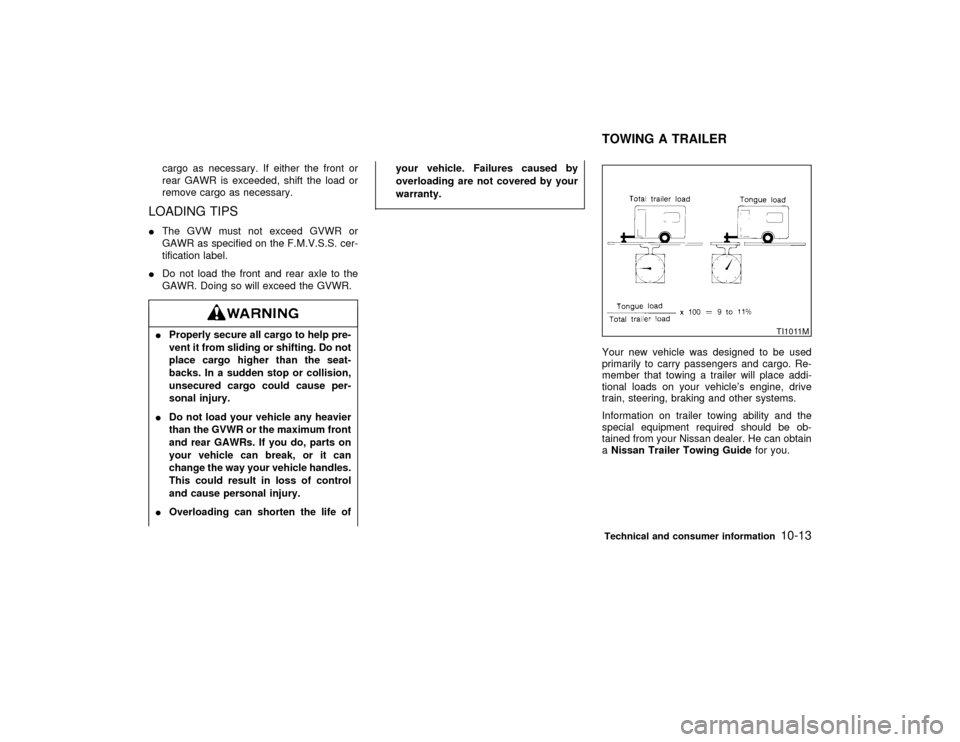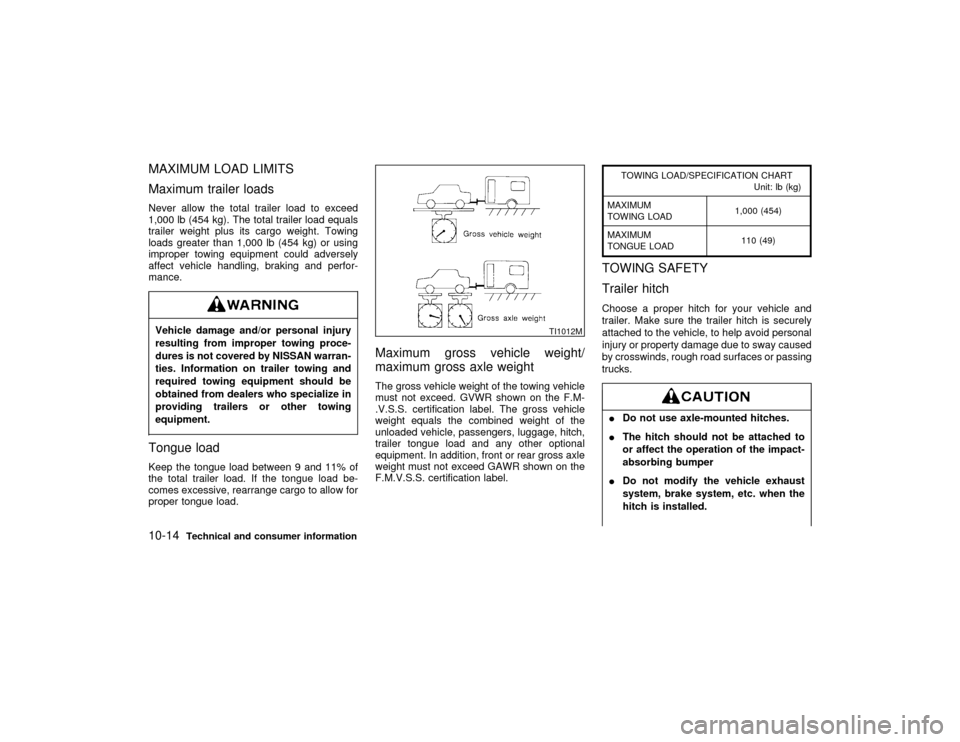1998 NISSAN MAXIMA trailer
[x] Cancel search: trailerPage 216 of 231

cargo as necessary. If either the front or
rear GAWR is exceeded, shift the load or
remove cargo as necessary.
LOADING TIPSIThe GVW must not exceed GVWR or
GAWR as specified on the F.M.V.S.S. cer-
tification label.
IDo not load the front and rear axle to the
GAWR. Doing so will exceed the GVWR.IProperly secure all cargo to help pre-
vent it from sliding or shifting. Do not
place cargo higher than the seat-
backs. In a sudden stop or collision,
unsecured cargo could cause per-
sonal injury.
IDo not load your vehicle any heavier
than the GVWR or the maximum front
and rear GAWRs. If you do, parts on
your vehicle can break, or it can
change the way your vehicle handles.
This could result in loss of control
and cause personal injury.
IOverloading can shorten the life ofyour vehicle. Failures caused by
overloading are not covered by your
warranty.
Your new vehicle was designed to be used
primarily to carry passengers and cargo. Re-
member that towing a trailer will place addi-
tional loads on your vehicle's engine, drive
train, steering, braking and other systems.
Information on trailer towing ability and the
special equipment required should be ob-
tained from your Nissan dealer. He can obtain
aNissan Trailer Towing Guidefor you.
TI1011M
TOWING A TRAILERTechnical and consumer information
10-13
Z
01.1.31/A32-D
X
Page 217 of 231

MAXIMUM LOAD LIMITS
Maximum trailer loadsNever allow the total trailer load to exceed
1,000 lb (454 kg). The total trailer load equals
trailer weight plus its cargo weight. Towing
loads greater than 1,000 lb (454 kg) or using
improper towing equipment could adversely
affect vehicle handling, braking and perfor-
mance.Vehicle damage and/or personal injury
resulting from improper towing proce-
dures is not covered by NISSAN warran-
ties. Information on trailer towing and
required towing equipment should be
obtained from dealers who specialize in
providing trailers or other towing
equipment.Tongue loadKeep the tongue load between 9 and 11% of
the total trailer load. If the tongue load be-
comes excessive, rearrange cargo to allow for
proper tongue load.
Maximum gross vehicle weight/
maximum gross axle weightThe gross vehicle weight of the towing vehicle
must not exceed. GVWR shown on the F.M-
.V.S.S. certification label. The gross vehicle
weight equals the combined weight of the
unloaded vehicle, passengers, luggage, hitch,
trailer tongue load and any other optional
equipment. In addition, front or rear gross axle
weight must not exceed GAWR shown on the
F.M.V.S.S. certification label.
TOWING LOAD/SPECIFICATION CHART
Unit: lb (kg)
MAXIMUM
TOWING LOAD1,000 (454)
MAXIMUM
TONGUE LOAD110 (49)
TOWING SAFETY
Trailer hitchChoose a proper hitch for your vehicle and
trailer. Make sure the trailer hitch is securely
attached to the vehicle, to help avoid personal
injury or property damage due to sway caused
by crosswinds, rough road surfaces or passing
trucks.IDo not use axle-mounted hitches.
IThe hitch should not be attached to
or affect the operation of the impact-
absorbing bumper
IDo not modify the vehicle exhaust
system, brake system, etc. when the
hitch is installed.
TI1012M
10-14
Technical and consumer information
Z
01.1.31/A32-D
X
Page 218 of 231

ITo reduce the possibility of additional
damage if your vehicle is struck from
the rear, where practical, remove the
hitch when not in use. Remove the
receiver when not in use. After the
hitch is removed, seal the bolt holes
to prevent exhaust fumes, water or
dust from entering the passenger
compartment.
IRegularly check that all hitch mount-
ing bolts are securely mounted.Tire pressuresIWhen towing a trailer, inflate the vehicle
tires to the recommended cold tire pressure
indicated on the tire placard (located on the
inside of the center console lid.)
ITrailer tire condition, size, load rating and
proper inflation pressure should be in ac-
cordance with the trailer and tire manufac-
turers' specifications.Safety chainAlways use a suitable chain between your
vehicle and the trailer. The chain should be
crossed and should be attached to the hitch,
not to the vehicle bumper or axle. Be sure toleave enough slack in the chain to permit
turning corners.
Trailer lightsTrailer lights should comply with federal and/or
local regulations. When wiring the vehicle for
towing, connect the stop and tail light pickup
into the vehicle electrical circuit at a point
between the sensor and stop light or light
switch.Trailer brakesIf your trailer is equipped with a braking sys-
tem, make sure it conforms to federal and/or
local regulations and that it is properly in-
stalled.Never connect a trailer brake system
directly to the vehicle brake system.Pre-towing tipsIBe certain your vehicle maintains a level
position when a loaded and/or unloaded
trailer is hitched. Do not drive the vehicle if
it has an abnormal nose-up or nose-down
condition; check for improper tongue load,
overload, worn suspension or other pos-sible causes of either condition.
IAlways secure items in the trailer to prevent
load shifts while driving.
IBe certain your rear view mirrors conform to
all federal, state or local regulations. If not,
install any mirrors required for towing be-
fore driving the vehicle.
Trailer towing tipsIn order to gain skill and an understanding of
the vehicle's behavior, you should practice
turning, stopping and backing up in an area
which is free from traffic. Steering stability, and
braking performance will be somewhat differ-
ent than under normal driving conditions.
IAlways secure items in the trailer to prevent
load shift while driving.
IAvoid abrupt starts, acceleration or stops.
IAvoid sharp turns or lane changes.
IAlways drive your vehicle at a moderate
speed.
IAlways block the wheels on both vehicle
and trailer when parking. Parking on a
slope is not recommended; however, if you
must do so, and if your vehicle is equipped
with automatic transmission, first block the
wheels and apply the parking brake, andTechnical and consumer information
10-15
Z
01.1.31/A32-D
X
Page 219 of 231

then move the transmission selector lever
into the P (Park) position. If you move the
selector lever to the P (Park) position be-
fore blocking the wheels and applying the
parking brake, transmission damage could
occur.
IWhen going down a hill, shift into a lower
gear and use the engine braking effect.
When ascending a long grade, downshift
the transmission to a lower gear and reduce
speed to reduce chances of engine over-
loading and/or overheating.
IIf the engine coolant rises to an extremely
high temperature when the air conditioning
system is on, turn off the air conditioner.
Coolant heat can be additionally vented by
opening the windows, switching the fan
control to high and setting the temperature
control to the HOT position.
ITrailer towing requires more fuel than nor-
mal circumstances.
IAvoid towing a trailer for the first 500 miles
(800 km).
IHave your vehicle serviced more often than
at intervals specified in the recommended
maintenance schedule.
IWhen making a turn, your trailer wheels will
be closer to the inside of the turn than yourvehicle wheels. To compensate for this,
make a larger than normal turning radius
during the turn.
ICrosswinds and rough roads will adversely
affect vehicle/trailer handling, possibly
causing vehicle sway. When being passed
by larger vehicles, be prepared for possible
changes in crosswinds that could affect
vehicle handling. If swaying does occur,
firmly grip the steering wheel, steer straight
ahead, and immediately (but gradually) re-
duce vehicle speed. This combination will
help stabilize the vehicle. Never increase
speed.
IBe careful when passing other vehicles.
Passing while towing a trailer requires con-
siderably more distance than normal pass-
ing. Remember the length of the trailer
must also pass the other vehicle before you
can safely change lanes.
ITo maintain engine braking efficiency and
electrical charging performance, do not use
fifth gear (manual transmission) or over-
drive (automatic transmission).
IAvoid holding the brake pedal down too
long or too frequently. This could cause the
brakes to overheat, resulting in reduced
braking efficiency.When towing a trailer, change oil in the
transmission more frequently.
See ªPeriodic maintenance schedulesº in
the ª9. Maintenanceº section.
10-16
Technical and consumer information
Z
01.1.31/A32-D
X
Page 228 of 231

Child seat belt ........................................... 1-18
Defects, Reporting................................... 10-18
Towing ..................................................... 10-14
Seat................................................................... 1-2
Heated ....................................................... 2-18
Seat adjustment
Front manual ............................................... 1-2
Front power ................................................. 1-4
Seat belt.......................................................... 1-17
Cleaning ...................................................... 7-5
Extender .................................................... 1-25
Maintenance .............................................. 1-25
Operation, Three-point .............................. 1-21
Precautions................................................ 1-17
Warning light and buzzer ............................ 2-8
With retractor, Three-point ........................ 1-20
Without retractor, Two-point ...................... 1-23
Selecting correct set of seat belt .................... 1-23
Servicing air conditioner ................................. 4-12
Setting, Clock.................................................. 2-25
Shoulder belt height adjustment (For front
seats) .............................................................. 1-22
Side air bag system ........................................ 1-13
Sound system, Audio system ......................... 4-12
Sound, Buzzer ................................................ 2-11
Spark plug....................................................... 8-16
Specifications .................................................. 10-7
Speedometer and odometer ............................. 2-4
Starting
Automatic transmission ............................... 5-4
Jump ............................................................ 6-7
Manual transmission ................................... 5-5
Precaution ................................................... 5-2
Push ............................................................ 6-9The engine .................................................. 5-6
Steering
Power ........................................................ 5-17
Wheel ........................................................ 3-13
Storage ........................................................... 2-19
Stuck, Vehicle recovery .................................. 6-12
Sun shade....................................................... 2-24
Sunroof ........................................................... 2-24
Supplemental
Air bag system .......................................... 1-12
Air bag warning label ................................ 1-15
Air bag warning light .......................... 1-15, 2-8
Restraint system.......................................... 1-7
Restraint system, Precautions .................... 1-7
Side air bag system .................................. 1-13
Switch
Front fog light ............................................ 2-16
Hazard warning ......................................... 2-17
Headlight ................................................... 2-15
Ignition ......................................................... 5-4
Rear window and outside mirror
defoggor .................................................... 2-14
Turn signal................................................. 2-16
T
Tachometer ....................................................... 2-4
Temperature gauge, Engine coolant ................ 2-5
Theft warning .................................................. 2-11
Three way catalyst ............................................ 5-2
Three-point type seat belt with retractor......... 1-20
Tire .................................................................. 8-31
Chain ......................................................... 8-33
Changing ................................................... 8-33Equipment, Cold weather .......................... 5-20
Flat............................................................... 6-2
Placard .................................................... 10-11
Pressure .................................................... 8-31
Quality grading ........................................ 10-17
Rotation ..................................................... 8-33
Type........................................................... 8-32
Tires, Specifications ........................................ 10-8
Top strap child restraint .................................. 1-34
Towing
A trailer .................................................... 10-13
Safety ...................................................... 10-14
Your vehicle............................................... 6-10
Trailer, Towing .............................................. 10-13
Transmitter
Integrated HomeLink
............................... 2-27
Multi-remote control..................................... 3-5
Traveling or registering your vehicle in another
country ............................................................ 10-9
Tray ................................................................. 2-19
Trunk
Lid ................................................................ 3-9
Light ........................................................... 2-27
Turn signal switch ........................................... 2-16
Two-point type seat belt without retractor (Center
of rear seat) .................................................... 1-23
Type of tire...................................................... 8-32
U
Underbody, Cleaning ........................................ 7-3
Unfastening the seat belt
Three-point ................................................ 1-21
Two-point ................................................... 1-24
Z
01.1.31/A32-D
X
11-5